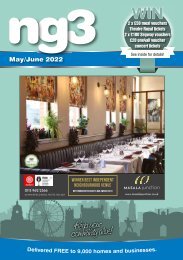NGV May/June 2022
Local business directory and community magazine
Local business directory and community magazine
- No tags were found...
You also want an ePaper? Increase the reach of your titles
YUMPU automatically turns print PDFs into web optimized ePapers that Google loves.
A Bonfire At Burton<br />
by Bob Massey<br />
On <strong>June</strong> 6 1838, Samuel Palin of Burton<br />
Joyce, along with his father John, was on the<br />
estate adjacent to the river watching the game<br />
birds in amongst the trees.<br />
While they were so occupied, William Marshall<br />
(aged 20) was walking down the lane adjacent<br />
to where they were standing. William proceeded<br />
along the lane to a load of timber piled up<br />
nearby. This wood was the property of Trent<br />
Navigation, who had staked it there some 18<br />
months before to allow it to be seasoned by the<br />
weather before using it along the river.<br />
Samuel watched William as he approached<br />
the pile and saw him proceed to climb up onto<br />
the stack. In this position, he removed several<br />
pieces from the top. Samuel now saw flames<br />
coming from the pile of timber and called to<br />
ask what he was doing. William climbed down<br />
off the stack and ran away, leaving the wood<br />
burning.<br />
Giving chase, Samuel caught William, who<br />
shouted; “dam your eyes if you tell on me I shall<br />
be transported”. Damaging property in this<br />
way had been a hanging offence but was now<br />
still punishable by transportation to Australia.<br />
Samuel asked why he had set the wood on fire,<br />
to which William replied that he was drunk and<br />
could not put the fire out. All three men then sat<br />
on the bank and watched the fire, as they had<br />
no way to extinguish the blaze.<br />
The next morning John Palin reported what had<br />
happened to Mr Padley and Mr John Hopkin,<br />
the agent for the Trent Navigation Company,<br />
on whose land the fire had been started and<br />
property destroyed. William was then arrested<br />
and sent to jail to await trial.<br />
The matter came to court seven months later, in<br />
January 1839. At the trial, William was defended<br />
by Mr Whitehurst, who objected to the charge<br />
of William setting fire to the wood, as neither of<br />
the witnesses had actually seen him start the<br />
fire. His objection however was overruled, so Mr<br />
Whitehurst then went on to address the jury at<br />
some considerable length.<br />
He stated that the prisoner was a simple,<br />
harmless, inoffensive man and that he regretted<br />
that the prisoner should have been held in<br />
custody and rendered liable for these offences<br />
punishable with possible transportation for<br />
life. He would not admit that the prisoner was<br />
guilty in any way. Several witness were called<br />
to vouch for William’s good character, including<br />
Wilson Plant, Thomas Hardy, William Foster, Mr<br />
Widdowson and Mr Slater, all local to Burton<br />
Joyce.<br />
John and Samuel Palin then gave their<br />
evidence. Both gave very similar accounts of<br />
the events as they unfolded. Neither could say<br />
for certain that they had seen William start the<br />
fire or how he could have done it.<br />
Although the jury verdict was guilty, Mr<br />
Whitehurst and the others witnesses must<br />
have carried some weight, as William was not<br />
transported for life, as would be expected, but<br />
received 12 months hard labour and 3 months<br />
solitary confinement.<br />
This was a very mild sentence at the time for a<br />
case of this type.<br />
I am researching the history of the <strong>NGV</strong> villages and would be very pleased to hear from anyone<br />
with more details or information. Email: bob.m.massey@gmail.com or post via ng magazines.

















